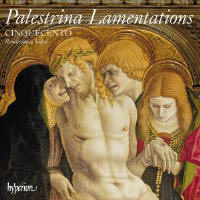Texte paru dans: / Appeared in: Code-barres / Barcode : /034571282848 |
|
|
Reviewer: J.
F. Weber Until 1970 the lamentations of the prophet Jeremiah (about half of the entire Scriptural book) made up the lessons of the first nocturn of Matins for Tenebrae, the last three days (Triduum) of Holy Week. Sung for centuries in an elaborate chant tone, they were given polyphonic settings by numerous composers including Morales (only three of them in Fanfare 32:3 and a partly different group of three on an earlier Astrée), Nasco (all nine on 25:3), Tallis, White, Lassus (three complete sets), Victoria (a dozen complete sets), Alonso Lobo (the seventh alone for some reason has been recorded repeatedly), Handl/Gallus (only five of them in 21:2), Festa (all nine on Pierre Verany, not reviewed here), Zelenka (six only, 15:1), Couperin (three only, most recently 40:3), and countless other Renaissance and Baroque composers.
Palestrina set the lamentations four times, but published only one set, in Rome in 1588 (1589 in Venice). I have not found a recording of this set, though Theobald Schrems seems to have recorded the first lamentation around 1962, since it does not match any of the other three settings. Here we have the first complete recording of Book 2, found in Lateran Codex 59 (dating from the 1550s). Single pieces had been recorded by F. John Adams (5:1) and Edward Higginbottom (most recently in a boxed set on Brilliant). Filippo Bressan recorded the first, seventh, and eighth lamentations for Tactus, while Dominique Vellard seems to have recorded the three for Holy Saturday for Deutsche Harmonia Mundi, since three to eight voices are specified there.
Book 3, composed in 1574, is the most well-known set, found in MS Cappella Giulia XV 21 and recorded by Olivier Opdebeeck on Jade, Simon Ravens (one disc for each night, 21:6, 23:6, 25:6), Martin Baker (31:1), and Guy Janssens on Sonamusica most recently. Janssens had earlier recorded the three for Good Friday (30:4) and Deborah Roberts recorded the three for Holy Saturday (33:3), while Jeremy Summerly (18:1) and Peter Phillips on Lamenta recorded single pieces. On Filippo Bressan’s badly garbled presentation on Tactus, he recorded the second and third lamentations.
Book 4, found in MS Ottoboniano 3387, was recorded by Bruno Turner and issued on many labels, most recently in a boxed set on Brilliant. All four sets were published in volume 25 of Haberl’s Opera Omnia (pages 20, 65, 124, 187). In addition (H. 31:161), an elaborate setting of the ninth lesson, the prayer of Jeremiah, is found in MS Lateran Codex 58 (contemporary with MS Codex 59), recorded in 1974 by Bruno Turner on Archiv LP and CD, and it was also recorded on Bressan’s Tactus CD. Turner wrote the notes for the present booklet, more informative than most, for most other recordings are annotated and cataloged so poorly that I had to listen to every recording to sort out the settings. Few works of liturgical polyphony can be more heartfelt than the music of Holy Week, in particular of Tenebrae, and most of all the lamentations and responsories. They can best be appreciated in the liturgical order provided by Olivier Opdebeeck on Jade for settings by Palestrina, Lassus, and Victoria; by Simon Ravens even more thoroughly as noted above; and on five other sets of Victoria. But a disc containing the lamentations alone has a special intensity that will be more easily appreciated after a familiarity with the complete presentations. In the context of the passion and death of Christ, Jeremiah’s lament over the destruction of Jerusalem is poignant in the extreme. To each lesson of the nine an appeal is appended: “Jerusalem, return to the Lord your God.” Just as the chosen people saw their exile as punishment for sin, the commemoration of the death of Christ would remind the faithful that their sins would be forgiven if they repented. Palestrina and other Renaissance composers put this awareness into every note of their music. Cinquecento must feel this deeply, especially in the unheated Carthusian chapel in Austria where the recording was made. Five men of this ensemble from as many countries had been doing this for 14 years before they took on this music from the composer’s years at St. John Lateran (1555–60). (Three singers join them for the final prayer of Jeremiah for eight voices.)
We might
ask why this set has been neglected until now, but the same neglect of his
published Book 1, not to mention 30 of his Masses, is just as hard to
understand. (To be sure, Book 1 is set more sparely for four voices.) In the
whole shellac era we had only Guillaume de Van’s 1938 recording of the ninth
lamentation on a single 78-rpm side, probably incomplete (but which one of
the five is unclear). In the 19th century his name alone stood for music
before Bach, but Bach is now complete on records while Palestrina is not. We
are fortunate that Cinquecento, which has devoted itself to neglected
composers, is equally concerned with neglected works of the masters. The
singing is exquisite, spun out relentlessly, culminating in a Jerusalem,
convertere that is subtly varied each time it occurs. The listener may
not notice, but the singers bring a new awareness to the words in each
changing setting. This is music to touch the soul, not to be passed up. | |
|
|
|
|
|
|
|
Cliquez l'un ou l'autre
bouton pour découvrir bien d'autres critiques de CD |
|




